John Janaro's Blog, page 60
February 8, 2023
Saint Josephine Bakhita Finds Freedom in Christ
In honor of the feast of Saint Josephine Bakhita, I present here the article on her conversion that first appeared in my monthly column in Magnificat in September 2014.
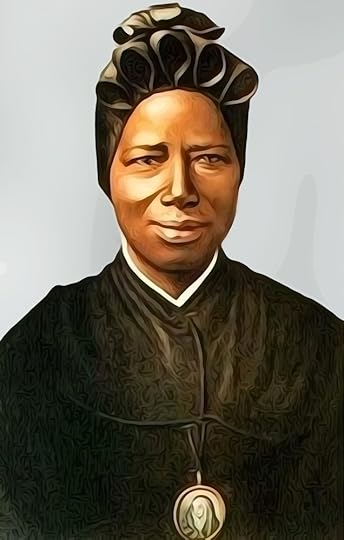
The Conversion Story of Saint Josephine Bakhita
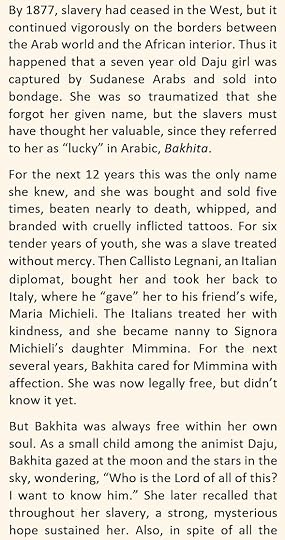
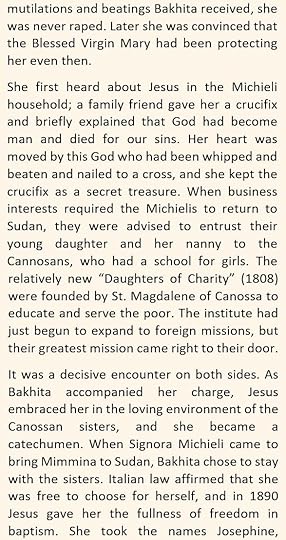

February 5, 2023
Too Many “Wasted Words”!
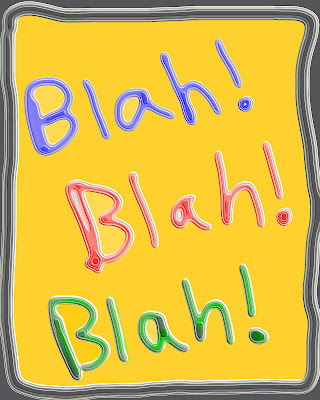 Sometimes I am frightened by all the words that fill our days with physical and mental noise. We have more words today than ever before in history, and more ways of saying them. So many of our words boil down to people saying things to people about other people. We call it conversation or even dress it up as "concern" for one another, or—depending on our media platform—opinion, journalism, scholarship, analysis, information, exchange of views, etc., etc., etc. Not to mention hostile comments on social media, Twitter mobs, and all the new ways the internet keeps devising for us to throw virtual mud at one another.
Sometimes I am frightened by all the words that fill our days with physical and mental noise. We have more words today than ever before in history, and more ways of saying them. So many of our words boil down to people saying things to people about other people. We call it conversation or even dress it up as "concern" for one another, or—depending on our media platform—opinion, journalism, scholarship, analysis, information, exchange of views, etc., etc., etc. Not to mention hostile comments on social media, Twitter mobs, and all the new ways the internet keeps devising for us to throw virtual mud at one another.What so much of it really is, in the end, is one form or another of self-affirmation, gossip, unnecessary curiosity, detraction, calumny, or cynicism. We use words to assert ourselves, or to make war on one another. And our words express what is inside our hearts. We have hearts full of violence.
I am perhaps more cautious in my choice of terms, but I am no less self-deceptive than anyone else when it comes to mudslinging or just plain talking too much. I have to ask myself, "How often, when I speak or write, am I truly seeking to point to reality, to build up life, to affirm what is good? How often are my words aimed at distraction, or at drawing attention to myself?"
How many wasted words! And yet I have a desire to speak the truth. I have the desire and the prayer that my words might be works of mercy and instruments of peace. Yet I am always running into my narrow, petty self.
I think perhaps we speak foolishly because we are insecure. We seek attention with our words, even at the expense of others. Why? Because we are afraid that we are not loved. Or, rather, we have forgotten that we are loved. We are not nourished by a vital connection with the One who loves us.
We need prayer. And not just more words of prayer. We need silence.
We need to let Him love us.
February 2, 2023
Forty Days After Christmas
"My eyes have seen your salvation, which you prepared in the sight of all the peoples" (Luke 2:30-31).
It's Forty Days after Christmas. Happy Feast of the Presentation of the Lord!

February 1, 2023
My Mom’s Search For Truth
 I decided to elaborate more on a recent post I made for the feast of Saint Thomas Aquinas. There was a childhood memory of my mother that I wanted to place in a larger context. It pertains to this text:
I decided to elaborate more on a recent post I made for the feast of Saint Thomas Aquinas. There was a childhood memory of my mother that I wanted to place in a larger context. It pertains to this text:I remember being four or five years old and my mother was folding the laundry and talking about the reading she was doing that was opening up her mind (and my mother had a huge, ardent, precise, and magnanimous mind). I have images in my memory from that conversation (and perhaps others): there were the two Popes (John XXIII and Paul VI) and the Council and somebody who had influenced her deeply but whose writings were confusing (that would have been the remarkable Jesuit paleontologist Pierre Teilhard de Chardin) but then a French Peasant who was a philosopher “corrected” her from going in the direction of the wild ideas that were brewing in 1960s “Teilhardism”… and, she was just learning so much. She radiated her still-youthful enthusiasm for truth and understanding.
And the four-year-old JJ was just imaging a French farmer-philosopher and whatever else and feeling that being Catholic and following the Church was not a narrow thing but an immense adventure of human reason and faith that embraced everything. Later I started noticing that wise old face of Jacques Maritain staring at me from the bookshelf on the spine of “The Peasant of the Garonne.” It was the radical beginning of my own intellectual vocation, and for many years (from childhood to age 58) it was an ongoing work that I shared with my brilliant mother. How grateful I am, and how much I miss her.
During those long-ago days, Mom was hardly confined to the laundry room of our apartment in Riverdale (northwest Bronx, NY). She had studied Chemistry in university and had an enduring fascination for the empirical sciences that served her well as a New York City public school Science teacher. She scaled back to being an “on-call” substitute teacher when my brother Walter and I came on the scene, but she continued her search for truth—especially in the area of the relationship between science and faith.
A voracious and intelligent reader, Mom first turned to Teilhard de Chardin (as did so many in those days) and was drawn to his arduous but confused efforts to articulate a Christ-centered scientific evolutionary cosmology. During his lifetime, this passionate scientist and devout Jesuit priest struggled to find words adequate for expressing his vast unprecedented vision for the synthesis of faith and scientific reason, but also humbly obeyed his Jesuit superiors who refused him permission to publish any of his speculative efforts in this area. Teilhard continued to grapple with his ingenious, powerful, perplexing, sometimes extreme intuitions until his death in 1955, accepting the continual rejections of his superiors as the will of Christ, as a suffering he was called to embrace. He also worked privately on his conjectural but (he was convinced) important thinking and writing projects, even in the face of the prospect that he might never be able to publish them.
Teilhard’s explorations have drawn attention to important problems, and may point toward a richer development of our understanding of the mystery of the Incarnation. They deserve (and have received, somewhat, over the years) careful and critical study by expert theologians who also have competence and training in the empirical sciences. Whatever Teilhard was up to at the time of his death, it was pretty clear that it required more work and some significant corrections. Time was needed for this work to be done in a sober manner, without excessive and premature enthusiasm.
But “the times they were a’changin…”🎶
After Teilhard de Chardin’s death, his many friends and colleagues published everything: Teilhard’s ideas—sometimes expressed in sweeping neologisms—hit the bookstores with all their raw poetic ardor for the progress of an evolutionary convergence of all things in the Cosmic Christ. But the actual face of Jesus of Nazareth and his redeeming death for our sins seemed to get a little lost in all the new terminology, much of which was ambiguous, incomplete, and—let’s be frank—just plain mistaken theologically (not to mention unverifiable scientifically). It goes without saying, of course, that these posthumous publications became wildly popular.
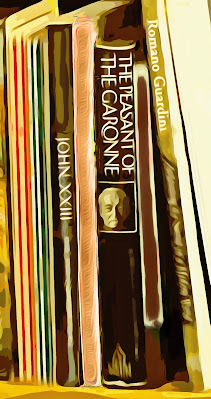 The “Teilhard de Chardin Fad” was launched onto the magical mystery tour of the psychedelic 1960s. But Mom never even got on that bus. Instead, she brought her fascination, her thoughts about faith and reason, her questions and her immense curiosity to the chaplain of the Newman Center at Hunter College. He listened to her patiently, and was able to discern the intellectual “meat” that my mother needed, and that she was ready for in her late 20s. He also realized that he only needed to recommend a few books, and Mom would construct her own “self-study.” He trusted that she would grow in her genuine intent to advance her intellectual life while remaining faithful to the Church’s magisterium (there were no graduate theology programs for lay students—much less lay women—in those days, but Mom would eventually earn her Master’s degree in theological studies in 1991). Without neglecting the other great thinkers of the era, this wise priest made sure that Mom would discover Saint Thomas under the direction of his most dynamic 20th century exponents. Mom read these books and acquired more of them. And she shared her great learning adventure—her growth in the knowledge of the truth—with me.
The “Teilhard de Chardin Fad” was launched onto the magical mystery tour of the psychedelic 1960s. But Mom never even got on that bus. Instead, she brought her fascination, her thoughts about faith and reason, her questions and her immense curiosity to the chaplain of the Newman Center at Hunter College. He listened to her patiently, and was able to discern the intellectual “meat” that my mother needed, and that she was ready for in her late 20s. He also realized that he only needed to recommend a few books, and Mom would construct her own “self-study.” He trusted that she would grow in her genuine intent to advance her intellectual life while remaining faithful to the Church’s magisterium (there were no graduate theology programs for lay students—much less lay women—in those days, but Mom would eventually earn her Master’s degree in theological studies in 1991). Without neglecting the other great thinkers of the era, this wise priest made sure that Mom would discover Saint Thomas under the direction of his most dynamic 20th century exponents. Mom read these books and acquired more of them. And she shared her great learning adventure—her growth in the knowledge of the truth—with me.I will always be grateful to Msgr. Herman Heidi (and my mother) for the fact that GIANTS occupied the bookshelves of my childhood home. Romano Guardini. Henri de Lubac. Jean Danielou. Others too. And, of course, the old peasant Jacques Maritain—lots of Maritain, but always in my memory the face of the (then) octogenarian hermit who went to live on the Garonne river with the Little Brothers of Jesus after his beloved wife Raissa died.
January 31, 2023
“Endure Your Trials as ‘Discipline’…”
 “Endure your trials as ‘discipline;’ God treats you as his sons. For what ‘son’ is there whom his father does not discipline? At the time, all discipline seems a cause not for joy but for pain, yet later it brings the peaceful fruit of righteousness to those who are trained by it.
“Endure your trials as ‘discipline;’ God treats you as his sons. For what ‘son’ is there whom his father does not discipline? At the time, all discipline seems a cause not for joy but for pain, yet later it brings the peaceful fruit of righteousness to those who are trained by it.“So strengthen your drooping hands and your weak knees. Make straight paths for your feet, that what is lame may not be dislocated but healed.”
—Hebrews 12:7-13
January 30, 2023
Chillin’ With You-Know-Who☺️
January 29, 2023
Twelve YEARS of “Never Giving Up”!
 This Blog appears to be aptly titled: Never Give Up is now 12 years old, and it shows no signs of… y’know, “giving up.” Why? Am I really that crazy?
This Blog appears to be aptly titled: Never Give Up is now 12 years old, and it shows no signs of… y’know, “giving up.” Why? Am I really that crazy? My Blog is still going strong, even though the “hits” on individual articles have plummeted to discouragingly low levels. (Although I don’t really know what those numbers signify.) Sometimes I feel like I’m “The Last Blogger.” I do see Blogs out there, but often their most recent posts are, like, from 2018. I’m not putting anybody down; in fact it’s perfectly reasonable. I wonder, however, how many current Blogs there are out there that have posted 200+ days every year for the past 12 years. And every post is still in the archives! (It’s also backed up on PDF files, and a couple of other formats.) I hope it will thus survive any Internet disasters that might come along, and remain accessible in some form in the future.
Right now, I probably have enough readers to put in a small classroom… for a seminar. I probably never had much more than that for most of my articles and posts. Sometimes all they get is an “experimental” (i.e. strange) piece of “digital art.” Other times they get pictures of a cute baby. But there is a fair bit of substantial (if rough) writing, and if I repeat the same themes over and over, it’s because I myself need to revisit and remember them again and again.
There is some material here that should be polished up and put into a more high profile publication. At this stage, I would need technical and editorial assistance to make that happen, and I have no way to hire anybody. It would have to be a labor of love for them (as it is for me)—and I mean the kind of love that looks like this: $0.00 per hour/day/week/month/etc.
I had a couple of Blogs prior to this one. I think I started my first Blog in 2006, when bloggery was already well-established. I was still teaching, and I tried to use it as a potential “new media” forum for interacting with my students. Didn’t have much success with that.🤪 In fact—dear former students, if you happen to be reading—it was one instance in which I deserved all the eye-rolls you gave me or at least wanted to give me (and it wasn’t the only instance, but it was one that I remember). Although I did offer chances for extra credit. People always want extra credit, right?😉
Around the same time, I joined that “Facebook” thingy. But it took me a few years to warm up to using social media. After my book Never Give Up: My Life and God’s Mercy was published in 2010, I began to do more stuff on the Internet. I asked my peeps on Facebook if they would be interested in me doing a Blog and of course there were plenty of people who said, “YES!” (There may have been plenty of others who thought, “No,” but they weren’t gonna post that in the comments.)
 Thus I became a “blogger” during what may have been peak season of Blog-dom. Everyone had a Blog. Some Blogs had huge followings and their authors were like rock stars in the world of new media. But then along came Twitter and Instagram and TikTok, turning everyone into producers (and consumers) of short, random, flashy multimedia “shows.” The last decade saw the evolution and extension of audiovisual interactive media on a scale beyond anything we could have imagined in 2011 (well, the folks with webcams making their own funky little videos on YouTube were ahead of the curve). Then, of course, screens shrunk to the size of cell phones even as they exploded with dazzling and distracting (or “engaging”) new kinds of content, and everyone has gadgets with tools to produce and/or share audiovisual “splashes” to the whole world. #️⃣HashtagGlobalVillage #️⃣HashtagNOISYGlobalVillage. Ah, McLuhan saw it all coming 60 years ago. He proclaimed it. He warned us about it.
Thus I became a “blogger” during what may have been peak season of Blog-dom. Everyone had a Blog. Some Blogs had huge followings and their authors were like rock stars in the world of new media. But then along came Twitter and Instagram and TikTok, turning everyone into producers (and consumers) of short, random, flashy multimedia “shows.” The last decade saw the evolution and extension of audiovisual interactive media on a scale beyond anything we could have imagined in 2011 (well, the folks with webcams making their own funky little videos on YouTube were ahead of the curve). Then, of course, screens shrunk to the size of cell phones even as they exploded with dazzling and distracting (or “engaging”) new kinds of content, and everyone has gadgets with tools to produce and/or share audiovisual “splashes” to the whole world. #️⃣HashtagGlobalVillage #️⃣HashtagNOISYGlobalVillage. Ah, McLuhan saw it all coming 60 years ago. He proclaimed it. He warned us about it.Meanwhile, blogging is dying. A hangover from the old “Gutenberg Galaxy.” Electronic publishing and distribution have certainly revitalized the printed word (or, rather, the virtually printed word). Books, flyers, newsletters are ubiquitous. The “printed word”—precisely because it is NOT printed—has discovered an unimaginable plasticity. The written word has never been bigger. It’s like a supernova, the last glory of a dying star. The more graphically malleable printed words become, the more they draw on the visual powers of the image. Might we even say, the more they merge with the image?
I’m not saying this is good or bad. I’m just trying to understand what’s happening.
Words are far from “dead,” of course. The written word will endure in all that is essential to it. Attentive writing (and attentive reading) will be rare, but then again that has always been the case. Most of the printed words of the Gutenberg epoch were not really necessary. The essential words will remain legible, and perhaps they may be crafted as they once were, with distinctive visual beauty (even new forms of beauty that will enrich the reading experience). Moreover, audio technology (think of audiobooks, podcasts, recorded lectures, etc.) has revitalized and rendered accessible in new ways the beauty of the sound of words and the possibilities for listening to the spoken word.
Maybe I should do a podcast?
Anyway, here is page one, January 29, 2011. Whatever form communication takes, it will never cease to be the gesture that Luigi Giussani speaks of here. And I will continue to pray for “more light and more strength.”

January 28, 2023
The Foundational Realism of Saint Thomas Aquinas
 No, this is not a philosophy paper. I just want to say “Happy Feast of Saint Thomas Aquinas!” I often celebrate the feasts of the great theologians and philosophers by “spending time” with their writings. I have spent lots of time in my life with Saint Thomas. I was educated as a lay student at the Dominican Pontifical Faculty in Washington D.C. (one of their first lay students, back in the mid-1980s). I have published work that deals extensively with Aquinas, and he has laid the “foundations and scaffolding” of the edifice (such as it is) of my extensive study of various modern thinkers. Many of them identify themselves as “Thomists,” among whom Jacques Maritain holds a special place, not only in my intellectual development and published work, but also in my “heart.”
No, this is not a philosophy paper. I just want to say “Happy Feast of Saint Thomas Aquinas!” I often celebrate the feasts of the great theologians and philosophers by “spending time” with their writings. I have spent lots of time in my life with Saint Thomas. I was educated as a lay student at the Dominican Pontifical Faculty in Washington D.C. (one of their first lay students, back in the mid-1980s). I have published work that deals extensively with Aquinas, and he has laid the “foundations and scaffolding” of the edifice (such as it is) of my extensive study of various modern thinkers. Many of them identify themselves as “Thomists,” among whom Jacques Maritain holds a special place, not only in my intellectual development and published work, but also in my “heart.” I remember being four or five years old and my mother was folding the laundry and talking about the reading she was doing that was opening up her mind (and my mother had huge, ardent, precise, and magnanimous mind). I have images in my memory from that conversation (and perhaps others): there was the two Popes (John XXIII and Paul VI) and the Council and somebody who had influenced her deeply but whose writings were confusing (that would have been the remarkable Jesuit paleontologist Pierre Teilhard de Chardin) but then a French Peasant who was a philosopher “corrected” her from going in the direction of the wild ideas that were brewing in 1960s “Teilhardism”… and, she was just learning so much. She radiated her still-youthful enthusiasm for truth and understanding.
And the four-year-old JJ was just imaging a French farmer-philosopher and whatever else and feeling that the being Catholic and following the Church was not a narrow thing but an immense adventure of human reason and faith that embraced everything. Later I started noticing that wise old face of Jacques Maritain staring at me from the bookshelf on the spine of “The Peasant of the Garonne.” It was the radical beginning of my own intellectual vocation, and for many years (from childhood to age 58) it was an ongoing work that I shared with my brilliant mother. How grateful I am to her. How much I miss her.
Years later I would study Maritain, dedicate several chapters of a book to his realist epistemology, and write his and Raissa Maritain’s conversion story. He is one of the great figures of 20th century Catholic philosophy whose influence has been pervasive in the articulation of post-conciliar Church teaching (especially through Paul VI but also John Paul II) even if his person and work have been largely forgotten… at least in this era. He will certainly be read in the future. He has much wisdom to share with emerging new civilizations that embrace the authentic dignity of the human person and an integral humanism.
I also studied and wrote about two very different 20th century Catholic figures who both incorporated Aquinas into their original proposals for the renewal of Catholic faith. My STL dissertation on Karl Rahner’s “supernatural existential” was the fruit of years of wrestling with the whole scope of the thought of this singularly brilliant Jesuit theologian. Rahner’s complex efforts to bring Aquinas into dialogue with elements of Kantian, Hegelian, and Heideggerian thought are often dazzling and ingenious, although in my opinion (and others too) ultimately unconvincing. But Rahner’s expositions and inquiries move in many directions and engage many questions in provoking and fruitful ways. My thesis argued that Rahner ultimately went “too far” in the development of his theory of the “supernatural existential,” and in fact changed his original proposal. It’s an extensive study that I really should scan and make accessible online… if I can find my original copy! There is a copy safely bound and shelved in the Dominican College Library, so if necessary I can just make a trip there and scan it from the shelf. It still occasionally pops up in footnotes in other people’s articles and books, so maybe I should put it on the Academia website.
The other great figure of the contemporary Church that I continue to study, who recognized the realism of Aquinas as vital to his own immensely fruitful evangelical witness, is—of course—Luigi Giussani. That work pops up in many places, including this blog, and the paper from my 1998 lecture series “Man in the Presence of Mystery” is accessible online (just go HERE).
But enough for now. The day is nearly over! I actually spent some time revisiting Chesterton’s famous little book on Saint Thomas. These days, when I read Chesterton, I can’t help literally laughing out loud, particularly when he makes gratuitous exaggerated statements off-the-cuff, with a twinkle in his eye, or goes off rambling on a tangent. There is less of that in his book on Thomas (though it’s not absent, and I had plenty of belly laughs today). Chesterton can get down to the point with a flair and brilliance and conciseness that evokes conviction. And let me assure you, the passages in Chesterton that annoy you at the age of 20 or 30 will be hilarious when you read them at age 60. G. K. Chesterton didn’t have a mean bone in his body. He was a magnanimous man, and ultimately he is funny because reality itself is funny, life is funny. Thomas Aquinas’s life has more than a few “funny moments” especially when you look at them within the perspective of God’s plan for this unique holy patient brilliant saint whose intellectual charism was destined to be a permanent gift to the Church and to humanity. Yes, there is humor to be found in any good story. Humor, one might say, is the little sister of Beauty.
I will leave you with a quotation from GKC about Aquinas’s realism that is not so much humorous as it is “getting to the point” with gallantry:
“The mind is not merely receptive, in the sense that it absorbs sensations like so much blotting-paper; on that sort of softness has been based all that cowardly materialism, which conceives man as wholly servile to his environment. On the other hand, the mind is not purely creative, in the sense that it paints pictures on the windows and then mistakes them for a landscape outside. But the mind is active, and its activity consists in following, so far as the will chooses to follow, the light outside that does really shine upon real landscapes. That is what gives the indefinably virile and even adventurous quality to this view of life; as compared with that which holds that material inferences pour in upon an utterly helpless mind, or that which holds that psychological influences pour out and create an entirely baseless phantasmagoria. In other words, the essence of the Thomist common sense is that two agencies are at work; reality and the recognition of reality; and their meeting is a sort of marriage. Indeed it is very truly a marriage, because it is fruitful; the only philosophy now in the world that really is fruitful. It produces practical results, precisely because it is the combination of an adventurous mind and a strange fact.” (G. K. Chesterton, Saint Thomas Aquinas, chapter VIII).
January 26, 2023
One More “Selfie”-Examination
 I realize that we have seen enough of my face this month, but I can’t resist one more comparison photo. Recently I came across an old plastic faculty ID card from the early 2000s with a worn out and scratchy picture of me at probably 41 or 42 years of age.
I realize that we have seen enough of my face this month, but I can’t resist one more comparison photo. Recently I came across an old plastic faculty ID card from the early 2000s with a worn out and scratchy picture of me at probably 41 or 42 years of age.So I set about “restoring” it with some AI filters. We all know that ID photos are famously unflattering, but the strained, weary, hollowed-out look of the man in this picture from two decades ago is not far off the mark. In those strange days, I was somewhere in the midst of debilitating illness and treatments that might have helped but were not much fun.
Does the current 2023 picture look “better”? I have been a bit run down lately, but generally speaking I have felt better overall the past decade (2013-2023) than I did in the period prior to it (2003-2013). Twenty years, in any case, brings a lot of changes.
I will say that if I had not “retired” from classroom teaching and administrative duties in 2008, there may never have been a picture from 2023. I am grateful that I got to live those days, and for whatever days remain ahead. May God grant me the grace to live them well.
January 24, 2023
Is There More Love and Kindness in Today’s World?
 I don’t think there is any way to “measure” love and kindness in a way that could answer the question of the title of this essay. In any case, it’s not a question that I know how to answer.
I don’t think there is any way to “measure” love and kindness in a way that could answer the question of the title of this essay. In any case, it’s not a question that I know how to answer.There are, however, some ways of taking up this question that might appear to lead us to an answer, but which ultimately prove to be reductive and inadequate. For example, sometimes our silly, overindulgent, comfort-saturated uber-affluent society fancies that “we” (and here we presume to speak for the whole human race) are all growing closer to one another—that we are learning to understand and celebrate everyone’s self-expression, and moving toward a more harmonious and unified life in our global village, and even a more authentic and inclusive “spirituality.” Overall, we’d like to feel good about ourselves in this respect.
Never mind for the moment that there’s a gruesome war going on which appears to be growing beyond anyone’s control, and that in many other conflicted parts of the world, nations are arming themselves to the teeth. The world, in fact, is becoming an ever more scary place, even if there are many sincere efforts to humanize the explosion of technology that is “bringing us closer together” whether we like it or not. We live in dramatic and dangerous times, in which many of us suffer from interior afflictions—often without realizing it—as we face unprecedentedly intense pressure and potential conflict in our daily affairs.
There’s not much tranquility in our real lives. We live in a condition of incomprehension and mutual suspicions, surrounded by potential conflicts with one another. These circumstances tend to complicate the mood of feathery optimism that we sometimes cultivate in our social milieu. Our subconscious defensiveness, cloaked under the pretense of “progress,” includes the promulgation of a few “new commandments” (which, when rightly understood, are valid in themselves): “Don’t judge people! Don’t condemn others! Be kind! Be tolerant!”
Here we even invoke the teaching of Jesus: “Do not judge” (Matthew 7:1).
The problem comes when these legitimate maxims—originally rooted in confidence in God’s providence and a respect for human dignity, and inspired by evangelical love—degenerate into pretexts for defining our human interactions evasively, in ways that precisely fall short of love. This happens when we say “don't judge" but what we really mean is “remain neutral, uncommitted, unconcerned about the real truth and happiness of another person." We wish in our minds to subtly dehumanize the other person, and pretend that their freedom is inconsequential and their choices therefore cannot weigh upon themselves or hurt us. We are, in fact, afraid to love.
We are afraid to take the risk of grappling with the provocation of a real human relationship with a person who is different from us, or who challenges us by their vulnerability—a person who needs help from us, but who also is a need for the Infinite Mystery, a fullness we cannot give them or ourselves."
And when we talk about "tolerance" and “inclusiveness” what we often really mean is that we want to define in distinctive (and distancing) categories people who are different from us in ways that make us feel uncomfortable, or whose actions and flaws we don’t understand, or whose suffering is beyond our capacity to resolve or empathize with. “Tolerance” can be a wall between people that they agree to build so that they can be protected from one another. Here again there is no room for love to grow, and there is the danger that ultimately we won’t care about anybody beyond ourselves and/or our own group.
This is the disease that festers beneath our pretenses of comfortable optimism. Under the disguise of superficial sentimental expressions of mutual affirmation, we are growing more alone, more isolated from one another.
But Jesus says that instead of judging and condemning one another we must love one another, give of ourselves to one another, forgive one another. This has never been easy, and in today's world it is in some ways harder than ever. Our drift toward isolation and anxiety is not entirely our fault. But we must not kid ourselves that our human relationships are healthy and secure, much less that our society had found the “key” to living together in peace, harmony, and enduring happiness for everyone.
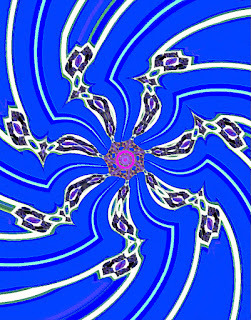
We are still at the threshold of an emerging "new epoch" dominated by power, and we must endure all the tumultuous intensity of its unprecedented experiments in "stretching" the capacities of human persons and environments. Finding ourselves in this bewildering and conflicted ambient, many of us are confused about our own identity, afflicted by trauma, and desperate to protect ourselves.
God alone judges us, and perhaps we can better appreciate this as a blessing. Even as the Lord sees us entirely and scrutinizes our hidden faults, he also knows all the complex circumstances that constrain us and that can diminish somewhat (and even to a significant degree) our culpability.
This brave new world, with its unprecedented and ongoing multiplication of so many kinds of power, smashes and breaks people in the places where they are vulnerable. It's a world of constant mental strain, and those who cannot keep up with the pace of its relentless, absorbing expansion of forces—or at least manage the stress—must shift through the wreckage it leaves behind in themselves.
These are traumatic times. Not surprisingly, many of us are traumatized. Naturally, we are trying to protect ourselves, and we seek out various forms of isolation, motivated by a combination of fear and the instinct for survival.
A few of us can try to hold on strictly by ourselves; we are the intellectuals who analyze everything and commit to nothing. More often, we are isolated "together" behind the fortress walls of our tribes—our illusory substitutes for commitment and community—bound together by violence and fear and the desire to make war on others.
But the light of the Gospel shines even in times like these. The Gospel addresses our whole humanity, and its power not only brings eternal life but also offers the best hope of subordinating the vast scope of our power to the wisdom of an integral humanism and a deeper awareness of the dignity of human persons called (and enabled by the Holy Spirit) to live together as brothers and sisters in Jesus Christ.
Jesus says "stop judging" and "stop condemning," but at the same time he says, "Give..." which is akin to the exhortation to love, to suffer for the sake of justice, to lose ourselves for his sake so that we might truly find ourselves.
But he does not only exhort us. He draws us on the path that he himself has made through the cross to the resurrection.




